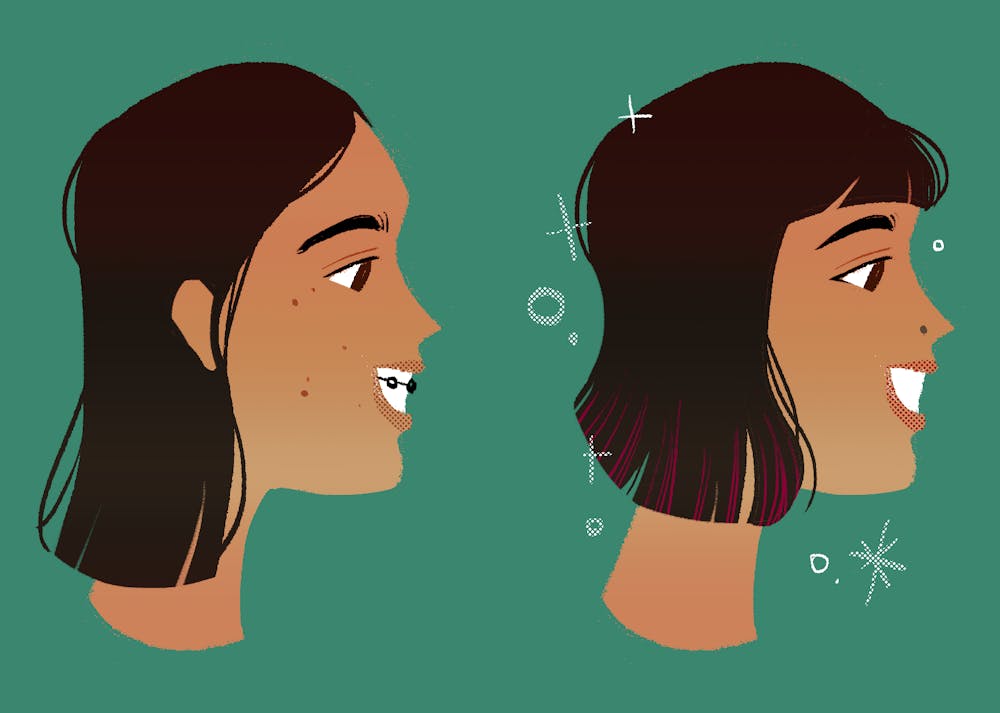What is a “glow up,” exactly? If you haven't been living in a cave without cell-service for the past five years, you've likely heard the term in a variety of different contexts.
Hypothetically, “glowing up” is just another term for maturing positively and noticeably, derived from “growing up.” The vast majority of glow up imagery on the internet, however, is focused on physical appearance. The hashtag #glowup on Instagram produces more than 4 million search results, and the same hashtag has over 14.7 billion views on TikTok.
Glow up TikToks often use the whiplash of sudden transformation as their gimmick, surprising the audience with the dramatic difference between the before and after of the glow up.
There is an entire genre of YouTube videos dedicated to the “24-hour glow up challenge,” where influencers explain the process of forcing themselves to become prettier in a short amount of time.
Sure, glowing up is a process, but on the internet, it’s dependent on a very specific end result, usually characterized by losing weight or gaining muscle, stylish clothes and a cheerful demeanor. How that end result is achieved is rarely, if ever, the subject of much scrutiny.
The glow up implies finality that one has reached the pinnacle of self-improvement and beauty. It doesn’t leave much room for continuing growth. It doesn’t idealize the hard, long work put into self-improvement, only the finished product.
Glow up critics
On May 5, the internationally acclaimed singer Adele posted a photo of herself on Instagram. The caption thanked her fans for their birthday wishes and essential workers for their sacrifices during the COVID-19 pandemic. The post made no reference to her own physical appearance.
Instantly, Adele’s fans on the internet noticed and commented on the singer's apparent weight loss in the photo, calling it a “glow up.” Tabloids jumped to cover the hype around her post and even major celebrities, including Chrissy Teigen and Lil Nas X, commented on her body transformation.
Others were quick to criticize this response to Adele’s change in appearance. Some called attention to the praise of her weight-loss’ potential to encourage or trigger those with eating disorders.
One author online called attention to the non-consensual nature of the internet’s reaction to Adele’s change, writing that “blindly engaging in a trend which normalizes commenting on a person’s body without their consent, then we’re fueling so many morally corrupted notions that undermine and dissolve body autonomy.”
Criticisms of “glow up culture” like these abound on the internet, but so do blogs outlining specific, concrete actions that those interested in glowing up can take to speed up the process. Many of these steps include dieting restrictions and treatments for skin disorders, like acne.
It’s likely telling that viral glow ups are popular on apps used by middle schoolers and teenagers, like TikTok and YouTube. Much of the internet’s glow up imagery could be characterized as the glorification of puberty, rather than the intentional choice to change one’s fashion sense or get in shape.
Search the hashtag #glowup on TikTok, and you’re likely to see most users in their young adulthood sharing comparison photos from their teenage years. This trend is alarming, considering the prevalence of eating disorders in America’s youth, which may be linked to social media use.
One study found 69% of girls ages 10 to 18 reported images on social media influencing their ideal body shape, claiming that “the rate at which teens are becoming aware of their body shape and size is getting younger and younger.”
There is also a growing body of evidence that suggests teenagers who spend more time on social media are at greater risk of developing a mental illness. It begs the question: How do viral glow up trends contribute to a toxic culture for children on the internet?
Celebrating change
For some, the concept of a glow up is one of positive personal growth, a celebration of progress and a motivator to become your truest self rather than a dismal indication of pervasive negative body image. In the LGBTQ+ community, physical transformations may carry a far different meaning than they might for cisgender heterosexuals.
Some glow up TikToks center the transgender experience, featuring creators sharing their appearances before and after medically transitioning.
Many people who are transgender experience some form of gender dysphoria — an emotionally and physically draining discomfort and disassociation with one's body. Many, but not all, people who are transgender seek some form of medical procedure to treat their dysphoria, be it hormone treatment or gender confirmation surgery.
Celebrating a viral glow up can be empowering and validating to the transgender experience, given the community's history of struggle against cultural and systemic barriers to access to transitional healthcare.
Perhaps glow up culture can be hijacked to raise awareness of these social issues and help normalize the process of medically transitioning, fighting transphobic stigmas along the way.
Hopefully, as our understanding of the internet's influence on mental health and body image evolves, so will our ability to critically examine how social media trends may positively or negatively impact their users.
Reach the reporter at lexmoulton@gmail.com and follow @lexmoul on Twitter.
Like The State Press on Facebook and follow @statepress on Twitter.




